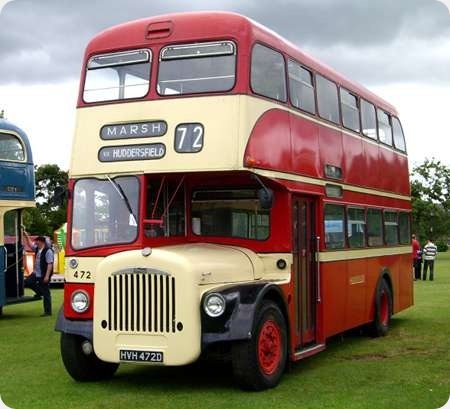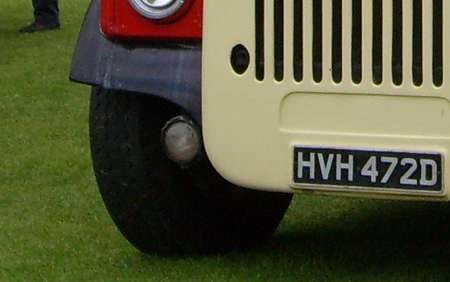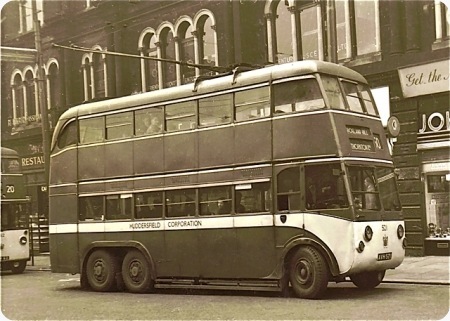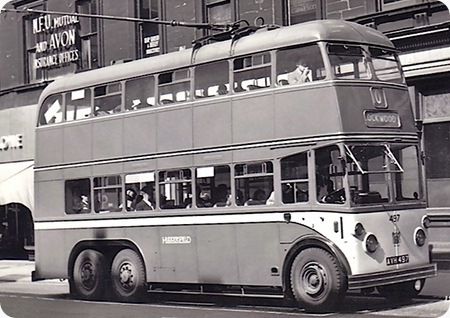
Photograph by ‘unknown’ if you took this photo please go to the copyright page.
Huddersfield Corporation
1938
Karrier E6
Park Royal H?/?R – rebuilt 1950 Roe H36/30R
Karrier E6 497 is seen in the mid fifties in Huddersfield Town centre on a through service from Brackenhall to Lockwood. This trolleybus formerly had a Park Royal body and entered service in 1938 but was withdrawn for a new Roe body fitted in 1950. The Corporation Transport Works carried out an extensive refurbishment work on the Karrier E6 chassis, control equipment and traction motor. Roe supplied an external body shell which was then internally finished by Huddersfield.
Twenty eight pre-war Karrier E6 trolleybuses were rebuilt in this way over a period from 1950 to 1954. Trolleybus 497 was in the first group of seven and coded class J1(R) and also one of a few with a narrow cream line rather than a cream band below the upper deck windows. Huddersfield continued this process of fitting new bodies to older chassis with their post-war Sunbeam MS2s from 1955 onwards up to 1962.
By 1963 all the Karrier E6 rebuilds were gone as route conversions to motorbuses took a hold. This rebodying process was always referred to by Huddersfield as a rebuild which was true for the pre-war Karrier E6s but perhaps not so for the post-war Sunbeam MS2s that received new Roe and East Lancs bodies.
Photograph and Copy contributed by Richard Fieldhouse
———
07/01/12 – 16:03
This comment less pic looks lonely. Could I set the ball rolling by querying the Roe-ness of this body? It seems to have a seam up the middle as if it was made like an Easter-egg. The driver’s corner looks Roe, but what about those bumps/vents above the full windows on the lower deck, and where’s the "familiar" trunking for the electrics between the upper deck windows.. and then there’s the bumpers. Must have been a hot day although they’re still wearing jackets….
Joe
———
07/01/12 – 17:49
Definitely a Roe body Joe. A lot of people think that the beading up the middle of the front panel was a result of partial replacement of the panel due to accident damage but I’m not so sure. If you look at almost any picture of a post war bodied Huddersfield Trolley, be it Park Royal, Roe or East Lancs they all seem to have this seam up the middle, even on pictures of new buses therefore I think it was a specification of the corporation. The front (and rear) bumpers were also a specification of the corporation on most batches of postwar bodies with the exception of the final batch of new trolley’s, 1959 Sunbeam S7A’s with E/Lancs bodies which had a removable panel at the bottom for use with a swan neck tow bar. These bumpers had variations of between three and five polished strips along them as well as other minor variations, even among vehicles of the same batch. These bumpers were usually discarded at first body overhaul.
I think that on this batch of bodies the trunking for the electrics may have run down the middle pillar of the front windows. This could certainly explain the front dome being split by beading to facilitate maintenance. Many of Huddersfield’s Roe trolleybuses even had vents in the front dome, as did the batch of 1958 Roe bodied exposed radiator Regent V’s for the JOC.
As an aside, the locals of Huddersfield always referred to the Trolleybuses as "Trolley’s" and the diesel buses as "Petrol’s". I can well remember an aunt of mine still calling the buses Petrol’s well into the 1970’s long after the trolley’s had gone.
Eric
———
07/01/12 – 17:56
Funny that Joe should say this. I hadn’t noticed any of those details, but what I did notice was that the upstairs rear emergency door window is divided in a manner that doesn’t look like contemporary Roe practice. I would have expected it to be either a single rectangular window, such as seen, for instance, on the internal shot of the “Ideal Service” Leyland PD2, or the earlier divided version in which the top frame of the two parts forms an arch, as seen on Ian Gibbs rear shot of the East Yorkshire (Beverley Bar) PD1. I guess there were many oddities with rebuilds. Does anyone have a rear view of one of these beasts?
Stephen Ford
———
08/01/12 – 07:55
Geoff Lumb’s excellent Roe/Optare book confirms the Roeness of the body. The two piece window in the rear emergency door was rare but not unknown. I think it was a Huddersfield quirk.
David Oldfield
———
08/01/12 – 07:56
Stephen, this is yet another oddity of Huddersfield. With very few early exceptions, ie: six NCB lowbridge Regent III’s delivered in 1949, almost all Huddersfield post war double deck bodies, be they trolleybus, motorbus, highbridge or lowbridge, Corporation or JOC, had divided rear windows on both decks until the advent of the first Fleetlines in 1967
Forgot to mention Stephen, whilst not of this particular batch of bodies there are a couple of rear views of the 1951 batch of Sunbeam MS2’s which had almost identical bodies when new, in the book ‘Huddersfield Trolleybuses’ by Stephen Lockwood published by Middelton Press in 2002
Eric
———
08/01/12 – 07:57
Stephen, to answer your query about the upper-deck rear window being divided, this was a feature specified by Huddersfield for all their post-war Roe bodies for both their trolleybuses and motorbuses.
Richard Fieldhouse
———
08/01/12 – 07:58
The twenty Rotherham Daimler single-deck trolleybuses that were rebodied as double deckers by Roe also had a divided emergency window, nothing like the standard single rectangular window that was fitted to three Roe motor bus bodies delivered to Rotherham around the same time, and which were followed later by many more.
What was most odd about the twenty trolleybus bodies, however, was the divided rear lower saloon window, definitely non-standard, but very eye catching all the same. I’ve often wondered who in the Crossgates drawing office dreamt that one up.
Dave Careless
———
08/01/12 – 07:58
Yet another interesting feature of Huddersfield Trolley’s was that the rear platform was at the same level as the lower deck floor, accessed by two steps on the platform edge, rather than the more usual lower platform and riser step into the lower saloon. Another unusual feature (am I boring you?) of the JOC motorbuses of this period was that the handrails on the rear entrances were insulated in black plastic, as per the requirement on trolleybuses, rather than the more normal plain aluminium. Right! I’ll shut up for now, (unless I think of something else) and hope my snippets have been of interest to somebody, somewhere.
Eric
———
08/01/12 – 16:35
When Wallace Arnold had the Daimler saloons acquired from Farsley Omnibus rebodied as double deckers they also had the large step flat floor to the platform layout.
Chris Hough
———
08/01/12 – 16:52
Yes, Eric, they are! The steps-up-to-rear-platform flat-floor layout was also found on some Roe motorbuses- eg Doncaster- in the fifties. Must be good for clippies.
Joe
———
09/01/12 – 07:28
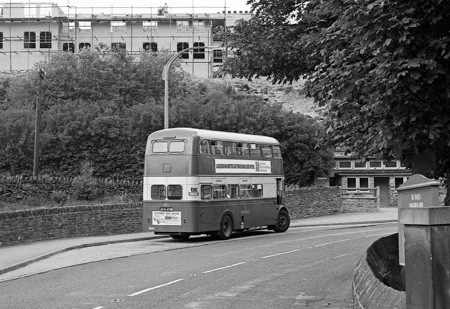
Here is a photograph of Huddersfield Daimler 431 at Holmbridge showing the two piece emergency exit. This was not unique to Huddersfield – Halifax’s Roe-bodied PD2s had this feature, in their case with each half containing a sliding ventilator.
David Beilby
———
09/01/12 – 07:29
Well Joe, you certainly got the ball rolling, the pic doesn’t look quite as lonely now!
Eric
———
10/01/12 – 07:15
I think you will find some reference to Halifax’s small batch of petrol engined AEC Regents in Geoffrey Hilditch’s excellent book Steel Wheels and Rubber Tyres Vol 2. They were delivered in April 1939 with Roe bodies and numbered 201-204, they were fitted with 9.6 litre twin carburettor petrol engines and proved more than capable of holding their own against the trolleybuses. A fuel consumption of around 3.5 mpg and war time restrictions saw them all receiving standard 8.8 litre diesels within a year of the outbreak of war. The above information is quoted from page 52 of the book mentioned initially.
Diesel Dave
———
11/01/12 – 06:40
Further to Eric’s comment on the level of the rear platform, I have a vague memory that this was due to the design of the Karrier chassis. I cannot now remember where I read this. If this is true, did Karrier trolleybuses for other users (eg Doncaster) have this feature? And did Huddersfield perpetuate the design on other makes of trolleybus chassis in order to maintain consistent passenger awareness, even if other makes would have allowed the more usual rear platform level? Maybe someone with a clearer memory or knowledge can deny or confirm this.
Michael Hampton
———
11/01/12 – 08:51
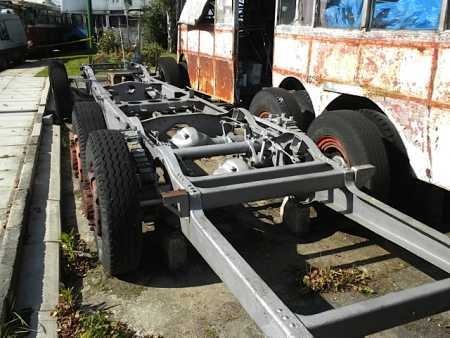
In answer to Michael’s question, the Karrier E6 chassis operated at Huddersfield had spectacle frames at the rear end, so no drop frame was possible and a high platform was a necessary feature. Above is a photo of Huddersfield Karrier E6 frame ex 470 at Sandtoft which shows this spectacle feature. All Huddersfield’s post-war trolleybuses had a drop frame chassis but they continued to specify the high platform for continuity. The only trolleybus operated in Huddersfield with a low platform was the AEC 663T/EEC no 6 later renumbered 406 and delivered in December 1933. I do believe other Karrier E6 trolleybuses such as those at Doncaster had a double step rear platform.
Richard Fieldhouse
———
15/01/12 – 07:14
Joe,
I’ve had another look at the photo of 497 and looking at the front dome I don’t think it has been divided. What looks at first to be beading down the middle appears, on closer inspection, to be a shadow cast in the strong sunlight, possibly by an overhead cable.
Eric
Leave it with me for a while will do some close ups
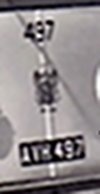
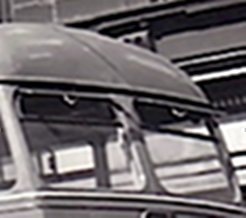
———
 Vehicle reminder shot for this posting
Vehicle reminder shot for this posting
———
15/01/12 – 16:32
I’m still thinking it’s a trunking or a moulding- very central- who knows?!
Going back to the step-up rear platform on motorbuses too- one example is the late Tony Peart’s Doncaster 122, an AEC/Roe with those funny cranked seats as well. I think there were other similar ones in the fleet around that time. Perhaps the idea came from necessity with these trolley rebodies.
Joe
———
16/01/12 – 07:39
Joe I remember asking Tony Peart once about the unusual seating arrangement in Doncaster 122 and he was able to explain to me the reasoning behind it.
Unfortunately I can’t remember what he told me.
Eric
———
16/01/12 – 07:42
West Riding’s Guy Arab IVs also had that platform layout – it was less obvious on the KHL-registered batch as they had folding doors which meant the platform step was set well inside and is very difficult to see on photographs. I have a theory as to why this layout was adopted and it relates to the combination of lowbridge layout and the safety staircase (which is why it only appears on Roe bodies). The problem with the safety staircase is that it tends to be longer as it’s largely straight. This is why early postwar Roe bodies have only 25 seats downstairs instead of the usual seat as the offside rear wheelarch seat was only for two.
This long staircase causes a problem with lowbridge bodies as you have difficulty getting to the rear seats. If the first step is incorporated in the platform, as with this design, that makes the staircase shorter and can help with the layout. As it was the penultimate row on the KHL Guy Arabs only seated two with the rear row seating three.
David Beilby
